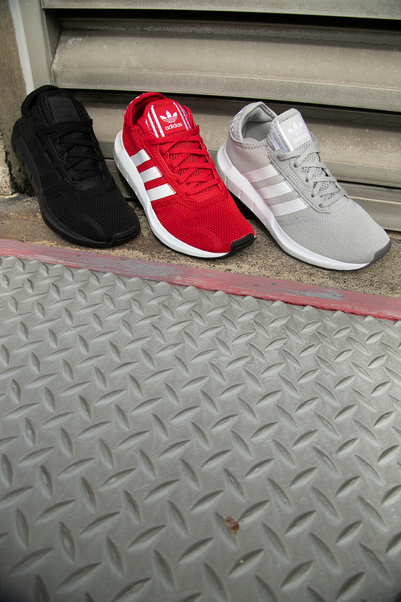A Shoe Guide for Runners
A Shoe Guide for Runners
 With many styles and options available, choosing a running shoe can feel overwhelming. Many different brands offer a myriad of styles, colors, and levels of support. Runners often wonder what's most important when choosing a running shoe. Experts agree that there are five major considerations when selecting a shoe, and color is not one of them.
With many styles and options available, choosing a running shoe can feel overwhelming. Many different brands offer a myriad of styles, colors, and levels of support. Runners often wonder what's most important when choosing a running shoe. Experts agree that there are five major considerations when selecting a shoe, and color is not one of them.
How Will You Use Your Shoe?
What you use your running shoe for is one of the main factors to consider when choosing a shoe. A shoe used for training for your first running race might not be the best shoe for trying to knock off a few seconds from a personal best. Runners on roads need one type of shoe, and those running on trails need another type of shoe. Most runners will probably succeed with a standard running shoe, but considering specific needs will help you find the perfect shoe for you.
- How to Choose the Best Road Running Shoes
- How to Choose Running Shoes That Work for You
- Finding the Right Running Shoe
- How To Choose The Right Running Shoes For you
- How to Choose Running Shoes
- Running Shoes Finder
- How to Choose Running Shoes
What Type of Surface Are You Running On?
Road Running - The hard surfaces of roads demands a running shoe that provides more cushioning. Road running shoes are also designed to stand up to daily wear that comes from hard surfaces. Water-resistant mesh uppers that breathe help keep your feet dry, which also helps prevent blisters.
Trail Running - Trail running involves dirt or compressed materials, requiring shoes that have better traction. Trail running shoes also help protect feet from rocks and slippery or muddy conditions. Trail running can be technical with lots of rocks and roots to avoid. Trail runners are built to be more durable and protective.
Treadmill Running - Running on a treadmill may feel more comfortable if you wear a running shoe with more cushioning. Treadmill runners might also choose lighter weight running shoes. The repetitive nature of treadmill running might necessitate shoes with more support to prevent repetitive stress injuries.
- Ask the Gear Guy: Do I Need Specific Shoes for Trail Running?
- Overview of Running Shoes
- How to Choose a Road Running Shoe
- New Runners: Advice for Finding the Right Shoes
- The Art of Choosing a Running Shoe
- Winter Trail Running Safety
- A Beginner's Guide to Trail Running
What Type of Running Should Your Shoes Handle?
Casual Running - Those running a few days a week, even signing up for the occasional 5K or 10K will probably be fine with a standard running shoe with average cushioning.
Long-Distance Running - Runners logging 25 to 30 miles per week might need more cushioning in their running shoes. Anyone who runs more than 10 miles at a time will definitely want to pay attention to the cushioning in the shoe soles. Remember, running shoes have a lifespan of between 300 and 500 miles.
Racing and Faster Running - Those watching the time might excel with shoes that have less cushioning, because they'll weigh less. These minimal shoes won't last for as many miles, but they are ideal for interval training and races.
- What's a Good Running Shoe for Me?
- Running Shoes Vs. Walking Shoes
- Best Running Shoes: How to Choose Guide
- Choosing the Right Running Shoe
- Everything You Need to Know About Your Running Shoes
- Choosing Running Shoes
- Quick Tips to Choose the Perfect Running Shoes
How Your Shoe Should Fit
Shoe fit can vary significantly between brands. Instead of automatically zeroing in on a shoe size, experiment with several different sizes to find the shoe that fits your feet correctly. Often, the correct fit is up to one full size larger than your actual foot measurement.
Shoe Length - You need a thumb-width space between your longest toe and the end of the shoe. Shoes that aren't long enough for your feet can cause blisters and black toenails.
Shoe Width - Feet shouldn't push against the sides of your shoes. Ideally, you'll want a secure fit that's not too snug. Standard running shoes come in D width for men and B width for women. Wider and narrower widths are also available.
Heel Fit - If your heels slip inside your running shoes, uncomfortable blisters might occur. Your shoes should fit securely around your heels, not letting them move or rub at all. Although you might try an alternative lacing method to keep your heels locked into your shoes, its better if your shoes fit correctly.
In-Step - The in-step of the foot is the space from the bottom of the arch to the top of the foot. Those with high arches will need more in-step space for comfort. If shoes feel uncomfortably tight when laces are tied, the shoes probably aren't the right fit.
- How to Choose the Best Running Shoe for You
- Finding the Right Shoe for Running
- 5 Tips for Choosing the Right Running Shoes
- Why Experts Recommend Buying a Running Shoe Half a Size Bigger
- Four Essential Keys To Athletic Shoe Fit
- 9 Signs You're Wearing the Wrong Size Running Shoe
- How Should Running Shoes Fit?
What Kind of Support Do You Need?
Everyone has a unique gait, which determines the type of support needed in shoes. Your gait is not a negative or positive attribute, it's simply the way you naturally move when you're walking or running.
Arch Types - Your arch also affects how your feet move and the type of shoe that will fit you best. Arches can be high, medium, or low. High arches may not absorb shocks well, so shoes might need extra cushioning. Low arches might lead to joint problems, so these feet need more stabilization. Medium arches typically pronate normally, so look for shoes with moderate support and stability.
Wear Patterns - Wear patterns include pronation, supination, and neutral. Pronation describes weight and foot movement that strikes more on the inside of the foot. This type of wear usually requires a shoe with more support to help prevent the foot from rolling too far inwards. Supination describes weight and foot movement striking more on the outside of the foot. To moderate supination, a more neutral shoe with less support should help more of the foot absorb the shocks. Neutral describes weight and foot movement that strikes in the center of the foot. Neutral wear usually doesn't need excessive support to keep the feet absorbing impact properly.







